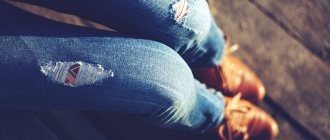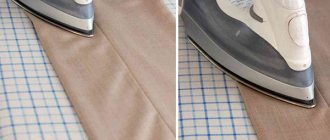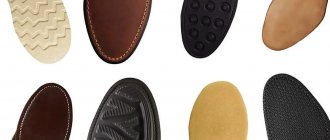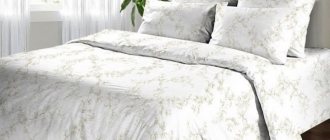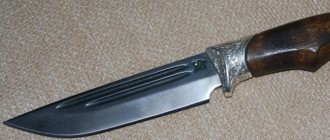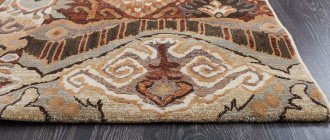Surely you love jeans too! And how can you not get attached to these durable and practical trousers - especially since they give comfort and at the same time allow you to look elegant. What can I say! Everything is fine in jeans, if not for one “but” - elongated knees! What elegance there is!
And still we will not give up our favorite clothes. And we will tell you how to deal with this problem.
How to return your jeans to their original shape?
To get your stretched shorts or trousers back to their original shape and fit, you just need to wash them in hot water. There are two ways: wash by hand; do this in the washing machine.
Interesting materials:
How is vacation transferred during the May holidays? How to recalculate vacation pay when recalled from vacation? How are vacation pay paid on salary? How is the advance paid after the vacation? How is maternity leave paid? How is vacation compensation paid? How is personal income tax paid on vacation pay? How to legally take vacation? How to divide a vacation into 2 parts? How to sign a vacation application for an employee?
How to get rid of blisters on your knees
If the fabric begins to bubble in problem areas, you can return it to its previous appearance in several ways.
Using fabric softener
- Take fabric softener, some warm water and a spray bottle.
- Pour three parts water and one part conditioner into a container. Mix well.
- Moisten the problem area with the resulting liquid.
- Spin the clothes in the washing machine on the drying cycle or dry them with a regular hairdryer.
Advice! If the problem cannot be resolved the first time, repeat the procedure.
Steam treatment
Another way to correct the situation is to use an iron with steam mode. To do this, smooth out the damaged fabric, periodically treating it with hot steam, until it returns to an acceptable appearance.
The same procedure to eliminate the “bubbles” effect can be carried out on damp jeans until they are completely dry.
Reference!
If you cannot tidy up the problem area yourself, you should turn to the services of specialists, a sewing studio.
Creative way
A good way to correct this defect is to take a creative approach to the problem. It is enough to decorate these areas with the help of “fake” patches, embroidery or appliqué made of colorful fabric or pieces of leather, and the stretched fabric will not be noticeable.
You can make decorative cuts on youth jeans, which are extremely popular at the moment.
Why jeans can stretch
Traditional twill jeans
made from 100% cotton, due to their own fiber structure, they stretch quite quickly in places that often force the fabric to stretch (on the buttocks and knees). Manufacturers know this, and, trying to avoid consumer dissatisfaction, add some specialized artificial lycra (or elastane) fibers to the fabric.
Removing blisters on knees
Just 2-5% elastane in jeans will make them soft and a little stretchy.
However, inexpensive models often have a much higher percentage of Lycra content than is permissible. This makes it possible to significantly save on natural ingredients, but makes jeans
fragile - the elastane threads, left without the support of their cotton counterparts, simply burst, and a small bubble forms at the site of the mini-accident.
What to do if jeans
stretched due to this reason? It is usually impossible to solve this problem.
Jeans
They can also stretch from delicate washing on a delicate cycle - due to the influence of washing powder and cold water, if the fabric is not good enough.
What if these jeans
and dry without spinning on a regular line, then you should not be amazed at the stretched item.
Hot drying and downsizing jeans
If your jeans are stretched
after washing, what to do in this case is very simple to understand: you can help the jeans shrink with proper drying. The first method is the most common: squeeze the jeans as hard as possible so that not a single drop remains on them, which would flow down and pull the fabric down, and hang it on a dryer or even on a hot radiator.
The item is guaranteed to become smaller by at least one size.
The second method is more suitable for thin and demanding fabrics: a piece of fabric that absorbs water well is laid out on the surface in a horizontal position, and jeans
unfolded, and the third layer is placed on another piece similar to moisture-absorbing fabric.
Jeans
sandwiched between two layers cannot
stretch
under the weight of flowing water, due to this they become a little smaller in size, or at least do not stretch.
The third method is incredibly simple: you need to place the jeans in a washing machine equipped with a hot drying function and set the required program.
The result will be the same as in the previous 2 methods.
What to do to prevent jeans from stretching at the knees
Let's also not neglect preventive measures. Professionals give some tips that will help you forget about such a nuisance as sprained knees.
- Try to purchase only quality items.
- Items made from elastic fabric .
- Don't wear jeans for several days in a row . After one day of wear, you should let the pants “rest” for a couple of days.
- Before sitting down, pull both pant legs up a little , and when you rise, run your palms over them, as if smoothing them.
- Do not wash jeans in hot water or boil them.
- When washing, be sure to turn them inside out and fasten all hooks, zippers and buttons.
- If you have steamed your jeans, you should not put them on right away!
- Make sure your jeans are completely dry before wearing them. After all, damp fabric is more susceptible to deformation.
- You can protect areas around the knees by gluing pieces of elastic material to them on the wrong side . A special fabric with hot-melt adhesive is suitable for this purpose.
- Sew several vertical, invisible stitches using matching thread in the area that is particularly exposed.
As you can see, nothing complicated! You should be a little more attentive to your favorite jeans so as not to worry about blisters on your knees. Well, if none of the above methods help, you will have to resort to a radical method: using scissors and shortening the legs to get flirty shorts.
Will breeches for weight loss help improve your figure for summer?
What should you be prepared for? Surprises and surprises of fashion 2019
Jeans are folded in the back: is this normal?
Hello girls! My question to you is: is it normal for jeans to “fold” in folds at the back and below the knee?
New jeans
, I bought them for myself a few days ago, from the brand Kaporal, (Kaporail), demi slim (semi-narrow), they contain 5-10 percent elastane, on me they are very comfortable, stretch well, but “go” with folds in the back. A size smaller - not comfortable, too tight, a size larger - even worse - they fold more. It is clear that these are not leggings, probably this is the material that is folded. Look at the photo.
Thanks for your comments.
How to correct defects in finished products
It is a rare woman who can boast of an ideal weight that she maintains for a long time. It usually changes for various reasons.
You can adjust clothes to your changing figure and continue wearing your favorite item. To reduce the size of your belt, you can use several options:
- Remove excess fabric from side seams.
- Hide it in the middle seam or dart.
- Add new darts or folds.
If you need to reduce the size just a little, it may be enough to alter a button or zipper. To reduce the width of your pants, follow these five steps:
- Try them on, mark the places that require stitching with white chalk or soap.
- Rip open your relatives.
- Mark along the marked lines.
- Put it on again to make sure everything is done correctly.
- Only after this can you sew the seams on a machine and process them with an overlocker.
To widen the trousers at the waist, you can make triangular inserts. To do this, you will need a similar fabric, but if you wish, you can play with contrast:
- Take the necessary measurements to calculate the size of the inserts. This will be the difference between the width of the waist and the length of the belt, divided in half.
- Cut two triangles from the fabric, the top edge of which will be equal to the calculated length, taking into account seam allowances.
- Open at the waist and lengthen it by sewing a rectangular insert into it.
- Open the side seams and sew triangular inserts into them.
- When everything is ready, all that remains is to carefully sew the parts together.
To make the side inserts invisible, you need to select the most similar fabric and threads, lay the lines as neatly and evenly as possible. If you are afraid that it will turn out badly, it is better to give the item to a professional dressmaker. Modern stores offer a wide range of trousers for every taste, color and size. Women have plenty to choose from.
But in order for them to fit perfectly, they must be adjusted to fit your figure.
Decrease belt size
Decrease the width of your pants
Widen the trousers at the waist
Useful tips for creating a pattern
Since women have different body shapes, the correct fit of trousers often requires adjustments to the pattern. This is easy to do if you know certain rules. How to modify a finished trouser pattern taking into account your body shape:
- Full hips: if you need to add less than 5 cm to the existing size, then you need to divide the adjustment amount by four, then add the resulting value on both sides of the side seam and smoothly connect the resulting points to the waistline and the bottom of the pattern. When it is necessary to enlarge the pattern by more than 5 cm, you need to cut it along the longitudinal line and spread it apart by ? differences in measurements.
- If it is necessary to modify the patterns to the size of the protruding belly, then the front part should be enlarged. To do this, you first need to cut the pattern along the middle lobar line, then across the bottom of the darts to the side seam line, then move the patterns apart by the required number of centimeters. Now all that remains is to redraw the dart and cut out the pattern.
- If a woman has a large difference between her waist and hips, then the patterns should also be changed. First of all, you need to measure your waist to calculate the difference. If it is 2-4 cm less than the pattern, then you need to measure according to the upper cut of the panels on both sides along the side cuts? from the established girth difference. Draw lines from the resulting points, which are smoothly reduced to the level of the hips. If the waist is 5-7 cm smaller, then you need to reduce it by 3-4 cm using the indicated method. Remove the remaining extra centimeters into darts.
- For X-shaped legs, the following method is used: at knee level, in the direction from the inside to the outside, cut the pattern not all the way (literally 1-2 mm) and move the parts apart by the size of the curvature - approximately 0.5-0.7 cm Connect with a smooth line.
- In the case of flat buttocks, you only need to reduce the step length of the rear halves and shorten them along the upper edge.
How to widen or space out your jeans waistband on the sides! by Nadia Umka!
For women whose waist is much thinner than their hips, low-rise trousers are best suited.
If all else fails, you can simply alter your jeans
Making jeans smaller using a needle and thread is a multifunctional method, the fabric will not deteriorate. And you can use it even if the stretch jeans are stretched, and it is not clear what to do, since it is quite difficult to give them the necessary shape with the help of water.
Jeans
You can take it to a sewing workshop or use the video instructions below and sew up denim trousers on your own in places where it is necessary.
Your ads will be inserted here by
Easy Plugin for AdSense
.
Please go to the plugin admin page to Paste your ad code OR Suppress this ad slot.
In reality, there are many more options to give the necessary shape to a stretched denim product, but the material provides only simplified and effective answers to the question: “What to do if jeans are stretched
?. But it is better to always remember that this difficulty can be avoided by purchasing high-quality items of the right size.
Types of denim and its ability to stretch
The first jeans were made of dense, hard and rough canvas called denim, thanks to this, fashionistas of that time did not even think about stretching things. Over time, the denim industry switched to using cotton, which, as everyone knows, also comes in a variety of varieties.
First of all, the fabric of jeans is divided into several options depending on the manufacturing option.
The most beautiful method is considered to be the specialized winding of fibers using ring spinning machines. This weaving became known as twill weaving and is considered to be of very high quality.
The second manufacturing option is faster: the threads are simply intertwined with each other using rotary pneumomechanical machines. Of course, this fabric is inferior in density and quality to typical wound denim. The quality of a material is also easy to determine depending on its origin. As a rule, the following manufacturers are known:
- Barbados – cotton from this country is soft and shiny. Due to the high price, it is less common on sale.
- Mexico - Cotton is made from long fibers, which allows the material to remain smooth and without a single scar.
- India and Asian countries are a very popular and affordable type of cotton, which is why it is found more often than others.
What percentage of elastane should be in jeans?
Finally, classic denim consists of 100% cotton, although recently elastane has increasingly been added to it - from 2 to 7%.
Interesting materials:
How to store boiled milk mushrooms? How to store a bicycle in the entrance? How to store things in the kitchen? How to store things without a closet? How to store pickled saffron milk caps? How to store greens so they don't wilt? How to store carrots in the basement in winter? How to boil a kettle after purchase? How to boil a kettle with lemon? How to boil kitchen towels?
What to do if your jeans are stretched?
Jeans
For a very long time they have occupied the main place in the wardrobe of today's man. Women and men of any age were able to rightfully appreciate this item of clothing. Nice, comfortable, stylish, they serve as a multifunctional base for a suit for various occasions. From the work and everyday wardrobe, jeans have gradually migrated to all areas of our lives. Weddings, social events, concerts - even at such special events, appearing in jeans is considered quite appropriate.
Quality jeans
can serve you for a very long time. But if washing tips are not followed, denim clothes can stretch.
If you somehow take jeans a couple sizes too big out of the washing machine or accidentally buy pants that are not your own size, don’t rush to get rid of the item. You can return your jeans to their original size at home. Read more about this below.
Knees stretch out on jeans, trousers: what to do
How to avoid such an unpleasant and unsightly phenomenon as the appearance of a blistering, elongated knee on jeans and trousers? Folds, wrinkles, and even more so bubbling fabric on the knees look careless and are a real horror for absolutely everyone who cares about their own appearance and the impression they create on others. If you're disgusted by wearing trousers or jeans in public that have become baggy at the knees or buttocks - the areas where the fabric is most constantly and heavily stretched, read the following expert advice that can help you get to the root of the problem and forget about blistering knees once and for good!
Why do knees stretch out on jeans and trousers?
All jeans (and trousers) stretch as much as possible in the knees and buttocks. Moreover, the better the fit of the trousers, the higher the likelihood that with intensive wear the fabric will become baggy, wrinkled, knees will appear on the trouser legs, and the butt will sag. The problem of baggy or wrinkled knees on trousers and jeans appears due to the fact that this item of clothing is made from a fabric consisting of only 1–2% flexible material (elastane) and 98–99% cotton/wool. Every time you sit down, you put frequent stretches on the knees and the “butt” of your pants, and when you stand up, that 1-2% of flexible material does not immediately return to its original shape, it takes time. Wrinkles, folds, bubbles, elongated knees are smoothed out over a certain period of time, but depending on how many seasons your trousers and jeans
how long and how you sat (many, for example, like to cross their legs or generally bend their knees as much as possible and tuck them under themselves)... This process can drag on longer and longer, until even washing and sagging can’t help and permanently elongated knees and a saggy “butt” will appear on your trousers. And at this moment you should decide for yourself that the time has come to purchase a new pair! How to make your trousers last longer and maintain an attractive shape?
What to do if your knees are stretched out on trousers or narrow jeans
- Wash your trousers in cold water and let them dry and relax under their own weight.
- If there is no way to wash your trousers, spray the blistering areas (knees, butt) with water and vinegar, shake and hang to dry, you can try to slightly weight the trouser legs with small weights so that the fabric straightens out better. If that doesn’t help, you can try ironing out the bubbles on your knees with vinegar and water.
- Tuck your trouser legs into your shoes or boots. If you have knees or unwanted folds on your jeans or trousers, but you don’t really plan to sit down in them for a long time, tuck the trouser legs into shoes or boots with a narrow and tight top - it will provide sufficient tension to the fabric and eliminate the appearance of bubbles on the knees.
What to do to prevent knees from stretching out on trousers and narrow jeans
- When you sit down, pull your pant legs up slightly so that your kneecap isn't pulling on the same area. This should help reduce the bags that appear over time.
- Wear a belt, especially if your trousers or jeans are loose at the waist. When moving or sitting, trousers that are loose at the waist may slide down onto the hips. When this happens, more tissue collects on the knees and they begin to wrinkle and blister.
- Do not wear pants when they are wet or damp if the fabric has become wet or damp due to rain or high humidity. Try not to sit in wet trousers, or at least not to bend your knees too much when sitting - when wet, the fabric stretches more, and when it dries, it tends to retain the shape it has taken all this time.
- Wash your pants frequently and allow them to sag and dry properly, straightening out under the weight of the wet material. Do not iron them until they are washed; you will iron dust and dirt in them, risking an unsightly shine on the fabric.
- Pants must be washed in cold water. Any item of clothing, including trousers, can shrink due to exposure to hot water. Heat damages most organic fabrics, causing clothing items to “lose” in size. Unfortunately, jeans
are no exception, and if you regularly wash your jeans in
hot water
, they will shrink. - If your trousers are made from a fabric containing wool - tweed, herringbone, etc. You can be saved from wrinkles and blisters on the knees by a lining cut along the side (across) and narrowed at the knee level by 0.5-1 cm. It can be sewn into ready-made trousers at almost any time or, if you are planning to get these, order trousers from a tailor with lining. It must be remembered that the lining is cut in accordance with the detail of the front of the trousers, but 15-20 cm shorter from the bottom. How does the lining save trousers? The fabric with six in it simply slides higher or lower on the lining and does not stretch.
What trousers to buy so that they don’t stretch out at the knees or on the “butt”
- Size is important - trousers and jeans should fit like a glove from the very beginning (given that the material tends to stretch over a certain period of time, it is advisable to measure trousers a size smaller). Just don’t buy jeans and trousers that don’t fit as they should in the store, that are blistered, wrinkled, etc.
- The material your jeans/pants are made from will affect how sensitive they are to knee bend and butt stretch. Therefore, make a choice in favor of very high-quality, expensive fabric (the greedy person pays more), denser material, with a high percentage of elastane.
- The cut of your trousers is also important. Very narrow models (skinny, pencil, cigarette/pipe, chinos) are more likely to stretch out and gather at the knees than trousers with a looser cut.
- And here you should decide for yourself whether to buy fitted trousers to highlight the slenderness of your legs, and then carefully watch to ensure that they do not develop a sprained knee, or to give preference to looser models and not bother yourself with all these hassles.
Correct fit of jeans - what is it like?
Two important rules to follow when adding a pair of jeans to your wardrobe are to take into account the type, strengths and weaknesses of your figure and choose the size wisely. Without taking these parameters into account, jeans will not fit well, namely, they will bunch up at the knees, at the back, in the groin, sag, etc. Let's see what popular jeans models are suitable for owners of different body types:
- Tight or skinny. This model lengthens the legs and emphasizes the hips. Suitable for triangle, rectangle and hourglass body types.
- Semi-loose or classic. They hide extra pounds and do not draw attention to “problem” areas - a full tummy, waist, hips. This is a good choice for ladies with a triangle figure - regular and inverted, hourglass, circle. Women with a rectangle figure should not choose this model.
- Spacious or boyfriends. They hide leg imperfections, emphasize the waist, and disguise narrow hips. Bad choice for "triangle" and "circle".
- High waisted. They make the legs visually longer, “narrow” the waist, mask folds in this area, but at the same time reduce height. Suitable for rectangle, hourglass and circle. Wrong choice for triangle.
- With a classic waist. They hide folds in this area, while making the waist “inexpressive”. Ladies with a rectangle and inverted triangle body type should not choose these jeans.
- Low waist. They lengthen the torso and accentuate the waist area. Disadvantages: emphasize flaws in the abdominal area, shorten the legs. Not suitable for circle and triangle shapes.
- Tapered. Makes the hips more rounded. Not suitable for ladies with curvy figures.
- Straight cut bottom leg. Masks leg imperfections. Suitable for ladies with almost any figure, except for the “inverted triangle” type.
- Knee flare. Reduces the volume of the upper torso, making the figure proportional. Not suitable for short people.
- Flare from the hip. Masks leg imperfections. The best option for ladies with curvy figures. Not suitable for "rectangle" and "triangle".
If you don't know what body type you have, here's a little cheat sheet to help:
- the chest and hips are equal in volume, and the waist is “noticeably” smaller - it’s an “hourglass”;
- with approximately the same chest and hips and an undefined waist, the figure type is called “rectangle”;
- if the chest is noticeably smaller in volume than the hips, and the waist is pronounced, then these are signs of a “triangle” or “pear” figure;
- accordingly, with an “inverted triangle” the opposite is true.
- if the parameters under consideration - chest, waist, hips - are approximately the same in volume, then this is the “circle” type.
Equally important when choosing a pair of jeans is to choose the right size. A small one will lead to the fact that when fastening the fly, the sides and stomach will simply “fall over” the edge of the clothing, a large one will “threaten” with the appearance of folds in the groin or under the buttocks, as well as the so-called “accordion” at the bottom of the legs.
